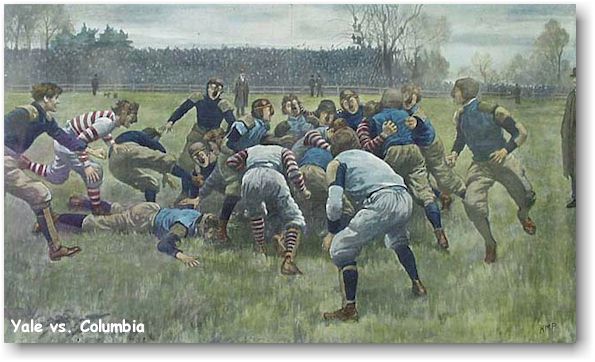During an early game of American Football, a pivotal moment took place when Yale athletic legend Walter Camp tossed the ball forward while in mid-tackle to his teammate Oliver Thompson, who then went on to score a touchdown. The opposing team, Princeton, protested as only backward passes to teammates. As it was an action performed in a tackle, the beguiled referee determined to settle the decision with a flipped coin. In the end, Princeton was supported, and the touchdown was nullified, along with the notion of a “forward pass” in American-style football.
Americans had been playing various non-codified games for decades already by the time modern football began to take form. Early in the nineteenth century, boys and men alike often played forms of “mob football” that date back to English games of time immemorial. Rules varied from town to town, with the “Boston Game” taking the lead as a hybrid of the diverging “kicking” and “carrying” games that would later evolve into Association Football (soccer) and rugby, respectively. The Oneida Football Club of boys on the Boston Common established rules in 1862 for the first organized take on what would become the modern game. It was an uphill battle, however, as football was routinely being banned from universities as too dangerous or unbecoming of gentlemen, and it would be years until these organized fellows went to college themselves with a proven formula for gameplay.
The bans on football ended, and colleges began to play one another in a loose intercollegiate league including Rutgers, Princeton, Yale, and Columbia. These big four schools met in 1873 to determine a standardized set of rules that would resemble soccer more than rugby. Meanwhile, Harvard, McGill, and Tufts continued the fascination with the Boston Game, more rugby than soccer and incorporating the “try”, which would evolve into the “touchdown” of carrying the ball into the end zone. In 1875, Harvard and Yale met for the first “The Game”, which became an annual event, and a new league was born as they decided to make the hybrid football the new standard for competition. On November 23, 1876, a new conference determined official rules for college football, among them making note of, but not clarifying, the forward pass.
In the Yale-Princeton game the next week, the forward pass would officially be laid to rest. Camp was disappointed with the choice, but he worked to determine a better, faster game where speed became as important as brawn. He created the line of scrimmage and a system of downs to move the game in increments, creating an ordered form of strategy and cleverness where there had once been only mobs. Camp also determined game length, field size, and scoring methods, creating the skeleton of what would be American football today.
Key to the game was the idea of movement, which would prove its most influential piece as the twentieth century dawned. Players typically followed mass formations, moving violently as one unit and often crushing opponents during a charge. In 1905 alone, nineteen young men were killed, and cries arose for safety on the field, even to the point President Theodore Roosevelt threatened to end football nationwide. An attempt to limit scrimmages was made, but the resulting punting game did not work well. With the forward pass having been declared illegal, the solution came to be ending mass formations, making each individual a significant piece to the eleven-member team.
Under Coach “Pop” Warner, one of the most influential football players of all time, Native American Jim Thorpe, would revolutionize the game with his expert moves. Pop did not want the fragile track star to play in football on fears he would be injured, but Thorpe convinced him to try a play against the defensive line and "ran around past and through them not once, but twice." Later that year, Thorpe would single-handedly score all of the points for Carlisle Indian Industrial School in an upset victory over the famed Harvard team, 18-15. Coaches across the nation hurried to emulate the apparent need for speed, finally matching Camp’s dream of a fast game working from a series of plays.
Since that time, American football has grown to enormous popularity and a multi-billion dollar industry. While America’s pastime of baseball became notoriously corrupt and slow, football has grown to be its rival, making key advances in its skillfulness and complex, eager maneuvers in high scoring games. Another rival, basketball, has taken its own season with some players in college crossing over due to the similarities in passing and running, but still with the unique feature of a pausing scrimmage and of course the famed tackles of blinding gymnastic agility.
--
In reality, the coin toss gave America its first forward pass. While still technically illegal, the pass would happen again in 1895 in a successful attempt by the Tar Heels to break a zero-zero tie between North Carolina and Georgia. After further experimentation, the forward pass was approved in the 1906 revisions and has become a mainstay of American football to this day.

This alt-history could go in the opposite direction. Without the forward pass, football becomes an even more violent game of smashing one's opponents. Injuries and deaths lead to a ban on the sport. The soccer and rugby variants take over, uniting the USA with the rest of the world. US participation in international tournaments lessens American feelings of exceptionalism and xenophobia, which reduces conflicts and increases peace.
ReplyDelete